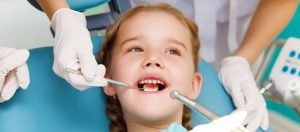Pediatric dentists promote the dental health of children as well as serve as educational resources for parents. It is recommended by the American Academy of Pediatric Dentistry (AAPD) and the American Academy of Pediatrics (AAP) that a dental visit should occur within six months after the presence of the first tooth or by a child’s first birthday.
Cleaning
[vc_single_image image=”569″ img_size=”full” alignment=”center” style=”vc_box_rounded”]
Indications:
Children that have inadequate plaque removal at home
Children that haven’t fully developed their hand dexterity
Children with poor nutrition
Children at risk for cavities
Patient Benefit:
This is a preventive procedure, it aids in the prevention of cavities, oral cancer, etc
There is complete removal of bacteria from the child’s mouth
Soft tissue is examined and screened for any abnormalities
This is the time that children receive hygiene education
Fluoride
[vc_single_image image=”570″ img_size=”full” alignment=”center” style=”vc_box_rounded”]
Indications:
Children at risk for cavities
Teeth with decalcification
Those that live in non-fluoridated communities
Patient Benefit:
Fluoride helps prevent smooth surface cavities
It can also reduce or stop the progression of beginning cavities
Sealants
[vc_single_image image=”571″ img_size=”full” alignment=”center” style=”vc_box_rounded”]
Indications:
Deep grooves on occlusal surfaces
Occlusal surfaces that are suspicious but not carious
Children with a high caries rate
Patient Benefit:
Sealants reduce the chance of decay on the biting surfaces of the teeth
These areas are difficult to clean and can decay easily
Great investment in the child’s oral health
Anterior Composites
[vc_single_image image=”476″ img_size=”full” alignment=”center” style=”vc_box_rounded”]
Indications:
Decay
Fracture, chip
Broken teeth
Fluorosis
Decalcification
Esthetics (peg lateral)
Patient Benefit:
Esthetics, self esteem
The removal of decay and the placement of a filling restores the original form and function of a tooth
Posterior Composites
[vc_single_image image=”572″ img_size=”full” alignment=”center” style=”vc_box_rounded”]
Indications:
Decay
Fracture, chip
Broken teeth
Decalcification
Malformed teeth
Patient Benefit:
The removal of decay and the placement of a filling restores the original form and function of a tooth
Posterior Amalgam
[vc_single_image image=”573″ img_size=”full” alignment=”center” style=”vc_box_rounded”]
Indications:
Decay
Fracture, chip
Broken teeth
Decalcification
Malformed teeth
Patient Benefit:
The removal of decay and the placement of a filling restores the original form and function of a tooth
Stainless Steel Crown
[vc_single_image image=”592″ img_size=”full” alignment=”center” style=”vc_box_rounded”]
Indications:
Primary molars with extensive mesial and distal decay
Malformed enamel
Advanced wear due to grinding
A missing permanent replacement tooth
A primary tooth that has had a pulpotomy, or large fracture
Class V decay
2 surface filling with recurrent decay on a tooth that will be retained for more than 1 year
Patient Benefit:
Primary molars, and in particular first primary molars with decay on more than one surface, will have the benefit of a much more durable and reliable restoration with a stainless steel crown
After placement, the tooth is once again healthy and in most cases will last until the tooth fairy says it’s time to go!
Extraction
[vc_single_image image=”575″ img_size=”full” alignment=”center” style=”vc_box_rounded”]
Indications:
Abscessed tooth/pain
Dual eruption
Crowding
Orthodontics
Patient Benefit:
Extractions save time, money and pain
Pulpotomy
[vc_single_image image=”576″ img_size=”full” alignment=”center” style=”vc_box_rounded”]
Indications:
Decay that involves the pulp on a permanent tooth
A pulpotomy removes the unhealthy tissues only in the crown portion in the tooth
Patient Benefit:
Removing the decayed portion of the root will help prevent further decay and an abscessed tooth
Pulpectomy
[vc_single_image image=”598″ img_size=”full” alignment=”center” style=”vc_box_rounded”]
Indications:
Decay that involves the pulp on a permanent tooth
A pulpotomy removes the unhealthy tissues only in the crown portion in the tooth
Patient Benefit:
Removing the decayed portion of the root will help prevent further decay and an abscessed tooth
Operculectomy
[vc_single_image image=”577″ img_size=”full” alignment=”center” style=”vc_box_rounded”]
Indications:
The removal of the operculum, or flap of tissue, that is covering the distal portion of a tooth
There may be a need for a filling or a sealant after the tissue removal
Patient Benefit:
An operculectomy allows access to a tooth that needs a filling or a sealant
Fiberotomy
[vc_single_image image=”593″ img_size=”full” alignment=”center” style=”vc_box_rounded”]
Indications:
This is the cutting of the fibers surrounding a tooth
This procedure is a request from an Orthodontist to prevent the shifting of teeth after treatment with braces
Patient Benefit:
By cutting these fibers, the “memory” of the tooth is stopped, and shifting is prevented
These fibers will reattach
Frenectomy
[vc_single_image image=”594″ img_size=”full” alignment=”center” style=”vc_box_rounded”]
Indications:
This is the removal of a frenum, a band of tissue that connects the lip to the cheek, or the tongue to the floor of the mouth
The frenum acts as a rubber band between the front teeth, sometimes preventing the space from closing
Patient Benefit:
Removal of this tissue creates the opportunity for the front teeth to mover together as they erupt
This will reduce the need for orthodontic treatment in the future

